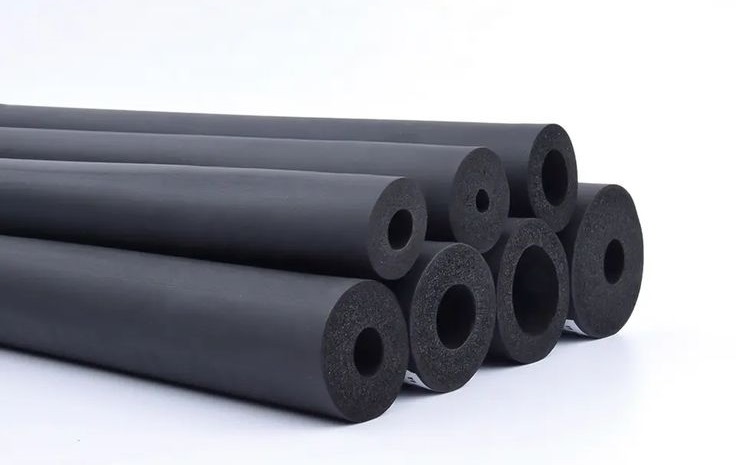In the demanding world of pipe systems, safeguarding against physical damage, energy loss, temperature extremes is critical. NBR/PVC foam is cost-effective for pipe protection, heat retention.
In the demanding world of pipe systems, safeguarding against physical damage, energy loss, and temperature extremes is critical. NBR/PVC foam stands out as a versatile and cost-effective champion for pipe protection, heat retention, and insulation. This unique blend harnesses the strengths of Nitrile Butadiene Rubber (NBR) and Polyvinyl Chloride (PVC), creating a material ideally suited for diverse piping applications. Discover why it's a top choice for engineers and installers.
Why NBR/PVC Foam? The Winning Combination
NBR/PVC isn't just a mix; it's a synergistic material offering properties often superior to its individual components:
1. Enhanced Durability & Protection: PVC contributes excellent abrasion resistance, toughness, and resistance to weathering, ozone, UV light, and many chemicals. This shields pipes from physical impact, sunlight degradation, and environmental exposure.
2. Superior Oil & Fuel Resistance: The NBR component provides outstanding resistance to oils, fuels, greases, and hydrocarbons – a crucial advantage over many pure PVC foams, especially in industrial and automotive settings.
3. Good Thermal Insulation Properties: The closed-cell foam structure traps air, creating an effective barrier against heat flow, minimizing unwanted heat gain or loss in pipes.
4. Effective Moisture Barrier: The closed-cell nature also acts as a vapor barrier, preventing condensation and corrosion under insulation (CUI), a major concern for metal pipes.
5. Flame Retardancy: Many NBR/PVC foams are inherently flame retardant or can be easily compounded to meet strict fire safety standards (e.g., UL 94, FMVSS 302), enhancing system safety.
6. Flexibility & Conformability: Remains flexible across a wide temperature range, allowing it to conform easily to complex pipe shapes, bends, valves, and fittings for seamless coverage.
7. Cost-Effectiveness: Offers a compelling balance of performance and price, often providing better overall value than more expensive elastomers for many pipe applications.
8. Ease of Fabrication & Installation: Can be easily cut, slit, glued, and formed on-site, simplifying installation around complex geometries.
Core Applications: Protecting Pipes & Preserving Energy
NBR/PVC foam excels in these key areas for piping systems:
1. Physical Pipe Protection (Jacketing):
o Abrasion & Impact Resistance: Shields pipes from mechanical damage during installation, maintenance, or from environmental factors (rubbing, impacts).
o Weather & UV Protection: Protects underlying insulation materials and pipes themselves from degradation caused by sunlight, rain, snow, and ozone exposure. Essential for outdoor piping runs.
o Chemical Splash Protection: Resists damage from oils, fuels, and many common chemicals encountered in industrial plants, refineries, or workshops.
2. Thermal Retention (Hot & Cold):
o Heat Conservation: Wrapped around hot water pipes, steam lines, and process heating pipes, NBR/PVC foam minimizes heat loss, improving energy efficiency and maintaining desired fluid temperatures. Reduces energy costs significantly.
o Cold Retention: Applied to chilled water lines, refrigerant pipes, and cryogenic lines, it prevents unwanted heat gain, ensuring cooling systems operate efficiently and preventing condensation/frost buildup on the outer surface.
o Personnel Protection: Provides a safe-to-touch surface on hot pipes, preventing burns.
3. Thermal & Condensation Insulation:
o Preventing Condensation: Its closed-cell structure and vapor barrier properties are paramount for insulating cold pipes. It prevents warm, moist ambient air from reaching the cold pipe surface, thereby eliminating condensation which causes water damage, corrosion (CUI), mold growth, and insulation failure.
o Energy Efficiency: By minimizing heat transfer (both loss and gain), it reduces the workload on heating and cooling systems, leading to lower energy consumption and operational costs.
o Freeze Protection: While not a primary heater, adding insulation like NBR/PVC foam significantly slows heat loss from pipes, helping to prevent freezing in vulnerable locations during cold weather.
Key Industries Benefiting from NBR/PVC Pipe Solutions:
· HVAC&R (Heating, Ventilation, Air Conditioning & Refrigeration): Insulating ductwork (especially exposed sections), refrigerant lines, chilled/hot water pipes, condensate drains. Preventing condensation is critical here.
· Industrial Processing: Protecting and insulating process pipes carrying hot/cold fluids, oils, chemicals, and steam in factories, chemical plants, power generation.
· Plumbing: Insulating domestic hot water pipes for energy savings and cold water pipes to prevent sweating.
· Automotive & Transportation: Insulating fuel lines, coolant hoses, and air conditioning lines within engine bays or chassis.
· Marine: Protecting and insulating pipes on ships and offshore platforms, where resistance to salt spray, moisture, and fuels is essential.
· Renewable Energy: Insulating pipes in solar thermal systems.
Why Choose NBR/PVC Over Alternatives?
· vs. Pure NBR Foam: Offers superior weather resistance, UV stability, abrasion resistance, and flame retardancy due to the PVC content. Often more cost-effective.
· vs. Pure PVC Foam: Provides significantly better oil, fuel, and hydrocarbon resistance thanks to the NBR component. Generally has better flexibility and compression recovery.
· vs. EPDM Foam: While EPDM has superior extreme temperature range and ozone/weather resistance, NBR/PVC typically offers better oil/fuel resistance and is often more cost-effective, making it ideal for applications where oils/fuels are present and extreme high temps are not the primary factor.
· vs. PE Foam: NBR/PVC generally has better temperature resistance, oil/fuel resistance, durability, and fire performance.
Selecting the Right NBR/PVC Foam:
· Density & Thickness: Dictates insulation value (R-value/K-value) and physical protection level. Higher density offers more protection but less flexibility.
· Temperature Range: Ensure the specific grade covers your operating temperatures (both min and max).
· Flame Rating: Verify compliance with required safety standards (e.g., UL 94, FMVSS 302).
· Chemical Resistance: Confirm suitability for the specific fluids or environmental chemicals present.
· Form Factor: Available as sheets, rolls, tapes, tubes (sleeves), and custom-molded parts.
Conclusion: The Essential Insulation & Protection Partner
NBR/PVC foam delivers a powerful combination of physical protection, thermal performance, moisture resistance, and chemical resilience specifically tailored for the challenges of pipe systems. Its ability to prevent energy loss, eliminate condensation, shield against damage, and resist oils/fuels makes it an indispensable material across HVAC, industrial processing, plumbing, and beyond. When reliability, cost-effectiveness, and performance for pipe applications are paramount, NBR/PVC foam consistently proves to be the go-to solution.


